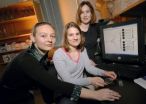(Press-News.org) Immunological research at the University of Haifa, Israel, has made a new breakthrough, revealing a critical component in the "decision-making" process of white blood cells that play a role in the healing process from bacterial inflammation. "The process that we have discovered can assist in the development of drugs that are based on the natural processes that take place in the human body, unlike most of the existing drugs that attempt to curb inflammation by artificial means," explains Dr. Amiram Ariel of the Department of Biology at the University of Haifa, who headed the study. The research and its results have been published in the scientific journal European Journal of Immunology.
Bacterial inflammation forms in the body when bacteria (pathogens) penetrate body tissue. In response, specific types of white blood cells (neutrophils) begin to fight the invaders, to destroy and remove them from the tissue. In normal conditions, inflammation is terminated once the cells have managed to eradicate the bacteria and then undergo programmed cell death. At that point, another type of white blood cells come on stage – macrophages – whose job it is to take up the dead cells (the neutrophils) and to restore the tissue to its normal functioning state. While the macrophages feast on their cell meal, they gain the ability to begin the tissue's rehabilitation process. However, at one point they abandon the tissue and make their way over to immune system organs, via the lymphatic system, where they deliver the "back to routine" message to the rest of the immune system. This message is important for the body's return to normal functioning. Until now, however, the when and how that directs macrophages' leaving the inflamed tissue remained unknown.
Dr. Ariel explains that even when the body manages to cope with the bacterial invaders, there is also the danger of "excessive" healing that will result in fibrosis and scar formation. This happens when the system reels out of control and "over-heals" the previously infected area. Fibrosis can lead to malfunctioning of the healing tissue, tissue death and sometimes even mortality. To understand why this happens, it is important to identify and understand the way macrophages' govern the healing process.
The current study, conducted by Dr. Ariel alongside a team of students led by Dr. Sagie Schif-Zuck, set out to probe the critical stage of the healing process, when the macrophages decide to relocate and adjust their healing activities, moving from local rehabilitation of the damaged tissue to shut down of systemic immune responses at organs of the immune system.
The researchers discovered that the macrophages have a fascinating "uptake threshold" of seven cells. After engulfing seven neutrophils they are "licensed" to leave the tissue and continue with their remote tasks. The research also found that these cells are sensitive to the tissue's healing pace, so that when the tissue is healing quicker, they are permitted to leave earlier, and when the tissue is finding it harder to repair itself, they hang around longer, even after reaching the uptake threshold of seven cells. The researchers also discovered substances that "inform" the cells on the tissue's rate of repair, and found that by injecting these substances, the macrophages' transition to immune organs is accelerated while new macrophages are recruited to further treat the damaged tissue and continue the healing process. In addition, the study revealed that as they leave the tissue, the macrophages undergo molecular changes necessary to carry out their new functions in the lymphatic system.
"Our new study has found a major event in the inflammatory healing process that is responsible for the transition of macrophages from local rehabilitation of the damaged tissue to its consequent role in promoting the immune system's return to routine. The findings from our study can assist in the development of biological drugs that are based on the body's natural processes and biomolecules. Today, most drugs are designed to block particular pathways in the inflammatory process, which is also a "fight back" strategy found in bacteria and viruses; but in many cases, the body relates to such a drug as a type of 'bacterial invasion', finds ways to circumvent it and produces an alternative immunological response to the blocked one. By harnessing the natural healing process that we have discovered, the body will be able to naturally complete and terminate all the inflammatory processes, and will be able to avoid the deficiencies of existing anti-inflammatory treatments," Dr. Ariel concludes.
INFORMATION:
For more details contact Rachel Feldman • Tel: +972-4-8288722
Communications and Media Relations
University of Haifa
press@univ.haifa.ac.il
How much can a cell uptake?
A new study from the Department of Biology at the University of Haifa has found how the 'decision-making' process works in cells that play a role in the healing of infection: The numbers count
2011-03-03
ELSE PRESS RELEASES FROM THIS DATE:
Atlanta Perimeter Hotel Announces a Special Deal that Lets Guests Pay Rates Equal to their Birth Year
2011-03-03
Sheraton Atlanta Perimeter Hotel North, located near Atlanta Perimeter Center, announces a new special savings deal that their guests can enjoy. The Pay Rates Equal to Your Birth Year promotion let's travelers celebrate the year that they were born. With this deal, the first night's stay at the Sheraton Atlanta Perimeter Hotel is $109. Then, stay a second or third night and pay rates equal to your birth year. For example, if you were born in 1952, you'll receive your 2nd and 3rd nights at just $52 per night. Rates for second and third night stays will be confirmed at check-in ...
Just like me: Online training helpers more effective when they resemble students
2011-03-03
Opposites don't always attract. A study from North Carolina State University shows that participants are happier – and perform better – when the electronic helpers used in online training programs resemble the participants themselves.
"It is important that the people who design online training programs understand that one size does not fit all," says Dr. Lori Foster Thompson, an associate professor of psychology at NC State and co-author of the study. "Efforts to program helper agents that may be tailored to individuals can yield very positive results for the people taking ...
Track and Field News: Oxygen4Energy Athlete, Kellie Wells, Dominates Indoor Season
2011-03-03
Track and Field News: Oxygen4Energy Athlete, Kellie Wells dominates the 2011 Indoor Season
There is just one word that describes the performances of Oxygen4Energy athlete, Kellie Wells, this 2011 Indoor Track and Field season... DOMINANT.
She ran in 6 meets.
She won every race she was in.
She currently holds the 9 fastest times in the World in the 60 m Hurdles.
In her first event of the year, she tied Jackie Joyner Kersee's 50m American Record.
In her last indoor event, she captured the National Championship with a PR of 7.79 seconds, making her the 3rd faster ...
Researchers predict age of T cells to improve cancer treatment
2011-03-03
Manipulation of cells by a new microfluidic device may help clinicians improve a promising cancer therapy that harnesses the body's own immune cells to fight such diseases as metastatic melanoma, non-Hodgkin's lymphoma, chronic lymphocytic leukemia and neuroblastoma.
The therapy, known as adoptive T cell transfer, has shown encouraging results in clinical trials. This treatment involves removing disease-fighting immune cells called T cells from a cancer patient, multiplying them in the laboratory and then infusing them back into the patient's body to attack the cancer. ...
Worms strike see-saw balance in disease resistance
2011-03-03
New research, funded by the Biotechnology and Biological Sciences Research Council (BBSRC) has shown that nematode worms have to trade-off resistance to different diseases, gaining resistance to one microbe at the expense of becoming more vulnerable to another. This finding, published in PLoS ONE today (2 March 2011), reveals that the worms, called C. elegans, have a much more complex immune system than was previously thought and shows how important such trade-offs are across the animal kingdom.
Dr Robin May from the University of Birmingham's School of Biosciences who ...
Medreturn, LLC Unveils Drug Collection Unit as the Safe, Secure, 24/7 Solution to Collecting and Disposing of Unwanted Prescription Drugs
2011-03-03
MedReturn LLC has been researching, developing, and testing a safe and secure method to collect expired prescription medication for the past three years. The effort culminated with development of a unique metal enclosure that is currently being placed in police departments and sheriff's offices across the country.
This effort is especially timely because President Obama signed the Secure and Responsible Drug Disposal Act on October 12, 2010 and the federal Drug Enforcement Administration National Prescription Drug Take Back Day, is April 30, 2011. It makes it possible ...
Shift work may be associated with decreased risk of skin cancer
2011-03-03
Boston, MA - Melatonin is known to have cancer-protective properties, and shift work can induce desynchrony of the circadian system, reducing melatonin production. Shift work has been thought to have important health impacts, with evidence linking shift work to an increased risk of several cancers including breast, endometrial, prostate, and colorectal, and non-Hodgkin lymphoma. In a recent study, researchers at Brigham and Women's Hospital (BWH) found that shift work may be associated with a reduced risk of skin cancer in women. These findings are published online in ...
Productivity and quality of grape vary according to plot of vineyard under cultivation
2011-03-03
Not all the terrain of the same vineyard has the same properties. Research undertaken by Neiker-Tecnalia (the Basque Institute for Agricultural Research and Development) confirmed that, over the same zone of cultivated land, there are plots with soils of different characteristics, a fact which gives rise to significant differences in the production of the grape and in the quality of the must. Knowing these differences enables the winegrowers to carry out zoning on their vineyards with the goal of better adapting to the needs of fertilisation, irrigation and treatment of ...
IL28B gene predicts treatment outcome for liver transplantation patients
2011-03-03
German researchers have found a significant association of IL28B genotypes to interferon-based antiviral treatment outcome, and to graft inflammation caused by hepatitis C virus (HCV). The study determined that the presence of G-allele serves as a marker for severe HCV-induced graft inflammation, as well as a predictor for unsuccessful treatment. Study findings—the largest to report on the role IL28B variants in a transplant cohort with recurrent HCV—are published in the March issue of Liver Transplantation, a journal of the American Association for the Study of Liver Diseases.
The ...
Fighting cancer at your local Indian restaurant
2011-03-03
Turmeric, a bright yellow spice from south Asia belonging to the ginger family, is the main ingredient in curries — and ancient wisdom suggests that it's also good for your health. Taking this wisdom to the laboratory, Tel Aviv University researchers have discovered that turmeric's active ingredient called curcumin amplifies the therapeutic activity of highly toxic anti-inflammatory drugs used to fight colon cancer when used at high doses.
Dr. Shahar Lev-Ari of Tel Aviv University's School of Public Health at the Sackler Faculty of Medicine and his colleagues have found ...
LAST 30 PRESS RELEASES:
New expert guidance urges caution before surgery for patients with treatment-resistant constipation
Solar hydrogen can now be produced efficiently without the scarce metal platinum
Sleeping in on weekends may help boost teens’ mental health
Study: Teens use cellphones for an hour a day at school
After more than two years of war, Palestinian children are hungry, denied education and “like the living dead”
The untold story of life with Prader-Willi syndrome - according to the siblings who live it
How the parasite that ‘gave up sex’ found more hosts – and why its victory won’t last
When is it time to jump? The boiling frog problem of AI use in physics education
Twitter data reveals partisan divide in understanding why pollen season's getting worse
AI is quick but risky for updating old software
Revolutionizing biosecurity: new multi-omics framework to transform invasive species management
From ancient herb to modern medicine: new review unveils the multi-targeted healing potential of Borago officinalis
Building a global scientific community: Biological Diversity Journal announces dual recruitment of Editorial Board and Youth Editorial Board members
Microbes that break down antibiotics help protect ecosystems under drug pollution
Smart biochar that remembers pollutants offers a new way to clean water and recycle biomass
Rice genes matter more than domestication in shaping plant microbiomes
Ticking time bomb: Some farmers report as many as 70 tick encounters over a 6-month period
Turning garden and crop waste into plastics
Scientists discover ‘platypus galaxies’ in the early universe
Seeing thyroid cancer in a new light: when AI meets label-free imaging in the operating room
Neutrophil-to-lymphocyte ratio may aid risk stratification in depressive disorder
2026 Seismological Society of America Annual Meeting
AI-powered ECG analysis offers promising path for early detection of chronic obstructive pulmonary disease, says Mount Sinai researchers
GIMM uncovers flaws in lab-grown heart cells and paves the way for improved treatments
Cracking the evolutionary code of sleep
Medications could help the aging brain cope with surgery, memory impairment
Back pain linked to worse sleep years later in men over 65, according to study
CDC urges ‘shared decision-making’ on some childhood vaccines; many unclear about what that means
New research finds that an ‘equal treatment’ approach to economic opportunity advertising can backfire
Researchers create shape-shifting, self-navigating microparticles
[Press-News.org] How much can a cell uptake?A new study from the Department of Biology at the University of Haifa has found how the 'decision-making' process works in cells that play a role in the healing of infection: The numbers count




